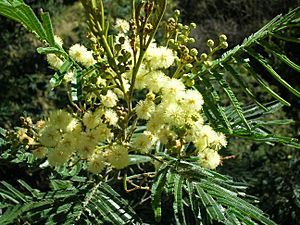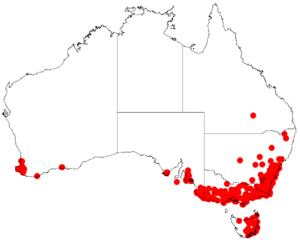Green wattle facts for kids
Quick facts for kids Green wattle |
|
|---|---|
 |
|
| Acacia mearnsii on Maui | |
| Scientific classification | |
| Genus: |
Acacia
|
| Species: |
mearnsii
|
 |
|
| Occurrence data from AVH | |
| Synonyms | |
|
|
The Acacia mearnsii, often called black wattle or green wattle, is a type of flowering plant. It belongs to the Fabaceae family, which includes peas and beans. This tree is originally from south-eastern Australia. It usually grows tall with smooth bark and special leaves. It also has round clusters of pale yellow flowers. After flowering, it grows black or reddish-brown seed pods. In some parts of the world, this plant is considered an invasive species, meaning it can spread too much and harm local plants.
Contents
What Does the Green Wattle Look Like?
The green wattle can be a spreading bush or a tall tree. It often grows up to 10 meters (about 33 feet) high. Its bark is usually smooth, but older trees might have rough bark near the bottom. The leaves are very interesting. They are called bipinnate, which means they have many tiny leaflets arranged in pairs. Each leaf can have 7 to 31 main branches, and each branch has 25 to 78 pairs of even smaller leaflets!
The flowers grow in round clusters. Each cluster has 20 to 40 pale yellow or cream-colored flowers. These flower clusters grow on hairy stems that are about 2 to 8 millimeters long. Green wattles mostly bloom from October to December. After the flowers, they produce long, flat pods that are black to reddish-brown. These pods can be 30 to 150 millimeters long and 4.5 to 8 millimeters wide. They usually appear from October to February.
Where Does the Green Wattle Live?
The green wattle is native to south-eastern Australia and Tasmania. However, people have introduced it to many other places around the world. You can now find it in North America, South America, Asia, Europe, and parts of Africa and New Zealand. In these new places, it's often grown to get tannin, a substance used in leather making, or as a source of firewood.
Green Wattle as an Invasive Plant
In some areas where it's not native, the green wattle is seen as a weed. This is because it can take over native habitats. It competes with local plants for water and nutrients. It can also replace native grasses and reduce the variety of plants and animals in an area. For example, in Africa, it competes for water and nitrogen, which are very important resources.
Native Habitat and Climate
In its home country of Australia, the green wattle grows in tall woodlands and forests. It prefers warm, mild climates. In Africa, where it has been introduced, it grows in disturbed areas, grasslands, and near rivers. It can grow in different climates, from warm and dry to moist and tropical. The green wattle can handle rainfall between 66 to 228 centimeters (about 26 to 90 inches) per year. It also likes temperatures between 14.7 to 27.8 degrees Celsius (about 58 to 82 degrees Fahrenheit). It doesn't grow well in very dry or poor soils.
How Green Wattle Helps in Australia
The green wattle plays a very important role in Australia's natural environment. It is a "pioneer plant," meaning it's one of the first plants to grow after a disturbance. After bushfires, which are common in Australia, the green wattle quickly helps to hold the soil. This stops the soil from washing away, which is called erosion.
Nitrogen Fixation
Like other plants in the pea family, the green wattle can "fix" nitrogen from the air. This means it takes nitrogen gas and turns it into a form that plants can use. It does this with the help of tiny bacteria that live in its roots. This process adds important nutrients to the soil. Other plants in the woodland can then use this extra nitrogen. So, green wattles are very important for helping Australian bushland grow back after fires.
Animal Interactions
Many animals interact with the green wattle.
- Seed Spread: Small animals like rodents and birds might help spread the seeds. People collecting wood can also accidentally spread them.
- Fungi: Special fungi called mycorrhizal fungi grow on the wattle's roots. They help the tree get food. In return, small marsupial animals eat these fungi and spread their spores in their droppings, helping the fungi grow in new places.
- Insects: The cracks in the wattle's bark are home to many insects. Rare butterflies, like the Tasmanian hairstreak, lay their eggs there. The caterpillars that hatch are then looked after by ants, which feed on sweet liquid from the caterpillars.
- Food for Birds: The tree is also home to grubs, which are a food source for Australian black cockatoos. These birds strip the bark to find the grubs.
- Nectar and Pollen: In winter, the black wattle provides nectar and pollen for insects, birds, and marsupials. This helps these creatures survive. The flowers have pollen rich in nitrogen, which attracts birds like wattlebirds and honeyeaters. The nectar in the leaf joints is also very nutritious for young birds and insects.
Mating Sites for Butterflies
Black wattles are often found on "hill-topping" sites. These are important places for male butterflies to find female butterflies for mating. The females then lay their eggs under the wattle's bark nearby. These sites are crucial for the butterflies to reproduce.
Seed Dispersal
Ants are attracted to the seeds by a fleshy, oily part called an elaiosome. They collect the seeds and bury them in different places. This helps the seeds to sprout when it rains. However, some insects can damage the seeds by sucking out the inside, which stops them from growing.
Uses of the Green Wattle
The Ngunnawal people, who are Indigenous Australians from the Australian Capital Territory, used the gum from the green wattle as food. They also mixed it with ash to make a type of cement. To get more sap, they would cut the bark in autumn. The bark was also used to make strong ropes and string. They even made a medicine for indigestion by soaking the bark in water.
Reproduction and Life Cycle
The green wattle produces many small seeds. These seeds are not actively spread by the plant itself. After a fire, the plant can grow new shoots from its base. It also produces many "suckers," which are new plants that grow from the roots, forming thick groups of identical plants. The seeds can stay alive and able to grow for up to 50 years!
Images for kids
See also
 In Spanish: Acacia mearnsii para niños
In Spanish: Acacia mearnsii para niños


